TIA-1 is a translational silencer that selectively regulates the expression of TNF-alpha
- PMID: 10921895
- PMCID: PMC306595
- DOI: 10.1093/emboj/19.15.4154
TIA-1 is a translational silencer that selectively regulates the expression of TNF-alpha
Abstract
TIA-1 and TIAR are related proteins that bind to an AU-rich element (ARE) in the 3' untranslated region of tumor necrosis factor alpha (TNF-alpha) transcripts. To determine the functional significance of this interaction, we used homologous recombination to produce mutant mice lacking TIA-1. Although lipopolysaccharide (LPS)-stimulated macrophages derived from wild-type and TIA-1(-/-) mice express similar amounts of TNF-alpha transcripts, macrophages lacking TIA-1 produce significantly more TNF-alpha protein than wild-type controls. The half-life of TNF-alpha transcripts is similar in wild-type and TIA-1(-/-) macrophages, indicating that TIA-1 does not regulate transcript stability. Rather, the absence of TIA-1 significantly increases the proportion of TNF-alpha transcripts that associate with polysomes, suggesting that TIA-1 normally functions as a translational silencer. TIA-1 does not appear to regulate the production of interleukin 1 beta, granulocyte-macrophage colony-stimulating factor or interferon gamma, indicating that its effects are, at least partially, transcript specific. Mice lacking TIA-1 are hypersensitive to the toxic effects of LPS, indicating that this translational control pathway may regulate the organismal response to microbial stress.
Figures
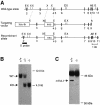
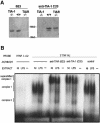

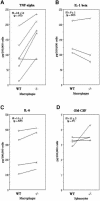

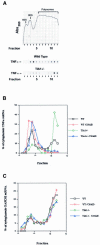
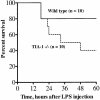
Similar articles
-
AU-rich element-mediated translational control: complexity and multiple activities of trans-activating factors.Biochem Soc Trans. 2002 Nov;30(Pt 6):952-8. doi: 10.1042/bst0300952. Biochem Soc Trans. 2002. PMID: 12440953 Review.
-
Arthritis suppressor genes TIA-1 and TTP dampen the expression of tumor necrosis factor alpha, cyclooxygenase 2, and inflammatory arthritis.Proc Natl Acad Sci U S A. 2004 Feb 17;101(7):2011-6. doi: 10.1073/pnas.0400148101. Epub 2004 Feb 9. Proc Natl Acad Sci U S A. 2004. PMID: 14769925 Free PMC article.
-
Posttranscriptional regulation of protein expression in human epithelial carcinoma cells by adenine-uridine-rich elements in the 3'-untranslated region of tumor necrosis factor-alpha messenger RNA.Cancer Res. 1997 Dec 1;57(23):5426-33. Cancer Res. 1997. PMID: 9393771
-
Mitogen-activated protein kinase-activated protein kinase 2 regulates tumor necrosis factor mRNA stability and translation mainly by altering tristetraprolin expression, stability, and binding to adenine/uridine-rich element.Mol Cell Biol. 2006 Mar;26(6):2399-407. doi: 10.1128/MCB.26.6.2399-2407.2006. Mol Cell Biol. 2006. PMID: 16508014 Free PMC article.
-
Post-transcriptional regulation of proinflammatory proteins.J Leukoc Biol. 2004 Jul;76(1):42-7. doi: 10.1189/jlb.1103536. Epub 2004 Apr 1. J Leukoc Biol. 2004. PMID: 15075353 Review.
Cited by
-
Interleukin-10 inhibits lipopolysaccharide-induced tumor necrosis factor-α translation through a SHIP1-dependent pathway.J Biol Chem. 2012 Nov 2;287(45):38020-7. doi: 10.1074/jbc.M112.348599. Epub 2012 Sep 6. J Biol Chem. 2012. PMID: 22955274 Free PMC article.
-
Post-transcriptional regulatory networks in immunity.Immunol Rev. 2013 May;253(1):253-72. doi: 10.1111/imr.12051. Immunol Rev. 2013. PMID: 23550651 Free PMC article. Review.
-
Contrasting pathology of the stress granule proteins TIA-1 and G3BP in tauopathies.J Neurosci. 2012 Jun 13;32(24):8270-83. doi: 10.1523/JNEUROSCI.1592-12.2012. J Neurosci. 2012. PMID: 22699908 Free PMC article.
-
Decreased sensitivity of tristetraprolin-deficient cells to p38 inhibitors suggests the involvement of tristetraprolin in the p38 signaling pathway.J Biol Chem. 2001 Nov 9;276(45):42580-7. doi: 10.1074/jbc.M104953200. Epub 2001 Sep 6. J Biol Chem. 2001. PMID: 11546803 Free PMC article.
-
A systematic analysis of disease-associated variants in the 3' regulatory regions of human protein-coding genes II: the importance of mRNA secondary structure in assessing the functionality of 3' UTR variants.Hum Genet. 2006 Oct;120(3):301-33. doi: 10.1007/s00439-006-0218-x. Epub 2006 Jun 29. Hum Genet. 2006. PMID: 16807757 Review.
References
-
- Berlanga J., Herrero,S. and DeHaro,C. (1998) Characterization of the hemin-sensitive eukaryotic initiation factor 2α kinase from mouse nonerythroid cells. J. Cell Biol., 273, 32340–32346. - PubMed
-
- Beutler B. (1999) The role of tumor necrosis factor in health and disease. J. Rheum., 26, 16–21. - PubMed
-
- Biragyn A. and Nedospasov,S.A. (1995) Lipopolysaccharide-induced expression of TNF-α gene in the macrophage cell line ANA-1 is regulated at the level of transcription processivity. J. Immunol., 155, 674–683. - PubMed
Publication types
MeSH terms
Substances
LinkOut - more resources
Full Text Sources
Other Literature Sources
Molecular Biology Databases
Research Materials
Miscellaneous

